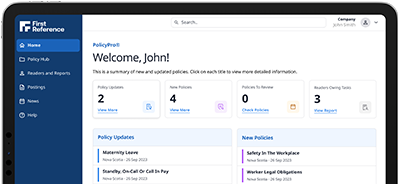
Top 10 HR compliance mistakes Canadian employers make (and how to avoid them)
First Reference
Ensuring HR compliance in Canada is essential for every employer—whether you’re a startup hiring your first employee or a large organization scaling your workforce. Yet, many employers unintentionally violate Canadian employment laws, putting their businesses at risk of lawsuits, penalties, and reputational damage.
In this article, we explore the top 10 HR compliance mistakes Canadian employers make—and provide practical strategies to avoid them.
1. Misclassifying Employees vs. Independent Contractors
One of the most common HR mistakes employers make in Canada is misclassifying workers to avoid payroll taxes and benefits.
- Why it matters: The Canada Revenue Agency (CRA) enforces strict rules about employee classification.
- How to avoid it: Use CRA’s “control test” to determine the nature of your working relationship. Misclassification can result in audits, fines, and back payments.
2. Failing to Comply with Provincial Employment Standards
Canadian labour laws vary by province. What’s legal in Alberta may not be in Ontario or Quebec.
- Common errors: Not paying overtime, incorrect vacation pay, ignoring break requirements.
- How to avoid it: Review your province’s Employment Standards Act and stay updated on any changes.
3. Improper Termination Without Cause or Notice
Terminating an employee without proper documentation or notice is a legal minefield.
- Risk: Wrongful dismissal lawsuits.
- Solution: Follow termination laws in Canada, including written notice, severance pay, and proper documentation.
4. Inadequate Recordkeeping and HR Documentation
Failure to maintain records like time sheets, performance reviews, and contracts can hurt your defense in legal disputes.
- How to fix it: Implement an HRIS or digital system to manage and store employee records securely and in compliance with retention rules.
5. Not Having a Workplace Harassment and Violence Policy
Workplace harassment and violence laws have evolved, especially under Bill C-65 (for federally regulated employers).
- Consequence: Legal penalties and unsafe work environments.
- Best practice: Implement a compliant policy and provide regular harassment training for all staff.
6. Overlooking Health and Safety Regulations
Employers are legally responsible for providing a safe workplace under the Occupational Health and Safety Act (OHSA).
- Risk: WSIB claims, fines, and employee injuries.
- How to avoid it: Train employees on health and safety protocols and maintain up-to-date documentation.
7. Ignoring Leave of Absence Requirements
Maternity, parental, sick, bereavement, and other protected leaves must be granted in compliance with Canadian labour laws.
- Common mistake: Denying or delaying leave requests.
- How to comply: Know the legal leave entitlements in your province and update your employee handbook accordingly.
8. Inconsistent Enforcement of HR Policies
Having a policy that you don’t follow can be worse than not having one at all.
- Problem: Discrimination claims and low employee morale .
- Solution: Develop clear HR policies and ensure consistent application across the organization.
9. Not Providing Reasonable Accommodation
Failing to accommodate an employee’s disability, religion, or family status violates human rights legislation.
- Tip: Having clear policies on accessibility and areas of documentation is important to manage accommodation. Document all accommodation requests and your efforts to meet them. Train managers on their responsibilities under the Canadian Human Rights Act.
10. Falling Behind on Legislative Updates
Labour laws in Canada change frequently: minimum wage increases, remote work laws, and updates to leave policies are just a few examples.
- Risk: Non-compliance without even knowing it.
- Prevention: Subscribe to HR tools like HRA, join professional associations like CPHR Canada, and consult legal counsel annually.
Final Thoughts on HR Compliance in Canada
Avoiding these HR compliance pitfalls isn’t just about avoiding penalties—it’s about building a transparent, fair, and legally sound workplace. Canadian employers who stay ahead of legal changes and implement HR best practices are better positioned to attract top talent and reduce risk.
Need help ensuring HR compliance?
One effective way to mitigate compliance risk from the outset is to use tools like PolicyPro and HRA from First Reference — a leading HR compliance and policy platform in Canada. First Reference provides up-to-date information on labour laws, templates for compliant HR policies, and practical guidance to ensure your processes—from onboarding to termination—align with provincial and federal legislation.
With First Reference, Canadian employers can:
- Access legally reviewed HR policies and employee handbooks
- Stay ahead of employment standards updates
- Confidently manage employee records, leaves, and terminations
- Reduce the risk of non-compliance and legal penalties
PolicyPro is Canada’s top HR/Payroll and Internal Controls Policy Management software. It’s a comprehensive toolbox to create and update policies, distribute them to staff, and properly track staff engagement by understanding and seeing who has read and complied with organization policies. Companies can find and create essential policies that meet legal requirements and industry standards.
Frequently Asked Questions
What are the most common HR compliance issues in Canada?
Some of the most frequent issues include employee misclassification, improper terminations, failure to provide protected leave, and lack of workplace safety protocols.
How do I stay compliant with HR laws in Canada?
Stay informed through HR networks, update your policies annually, and ensure all managers are trained in key compliance areas. Reach out to us at First Reference.
Can I use the same HR policies across different provinces?
Not always. While federal laws apply to certain sectors, each province has unique employment standards. Customize your policies accordingly. Speak to us.
Table of Contents
Compliance Made Easy®


